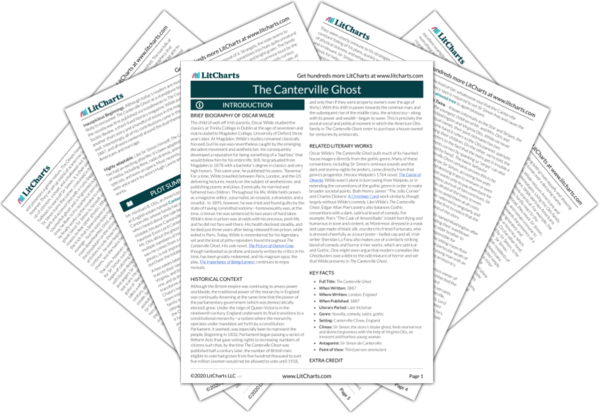Welcome to the LitCharts study guide on Oscar Wilde's The Canterville Ghost. Created by the original team behind SparkNotes, LitCharts are the world's best literature guides.
The Canterville Ghost: Introduction
The Canterville Ghost: Plot Summary
The Canterville Ghost: Detailed Summary & Analysis
The Canterville Ghost: Themes
The Canterville Ghost: Quotes
The Canterville Ghost: Characters
The Canterville Ghost: Symbols
The Canterville Ghost: Literary Devices
The Canterville Ghost: Theme Wheel
Brief Biography of Oscar Wilde

Historical Context of The Canterville Ghost
Other Books Related to The Canterville Ghost
- Full Title: The Canterville Ghost
- When Written: 1887
- Where Written: London, England
- When Published: 1887
- Literary Period: Late Victorian
- Genre: Novella, comedy, satire, gothic
- Setting: Canterville Chase, England
- Climax: Sir Simon, the story’s titular ghost, finds eternal rest and divine forgiveness with the help of Virginia Otis, an innocent and fearless young woman.
- Antagonist: Sir Simon de Canterville
- Point of View: Third person omniscient
Extra Credit for The Canterville Ghost
Inauspicious Beginnings. Although today’s readers are most likely to encounter The Canterville Ghost as a standalone book, the novella was first published via installments in The Court and Society Review, a short-lived literary magazine. Wilde published another short story and a handful of essays in the magazine as well. Interestingly, all of his contributions came in the year 1887, and all were centered around the dual themes of Americans and marriage.
Highly adaptable. Like Sir Simon himself, The Canterville Ghost has had an exciting afterlife: it’s been adapted to a wide variety of media, including films, radio dramas, animated television specials, and even an opera. Most recently, an animated film with voice work by actors Hugh Laurie and Stephen Fry is in the works.







